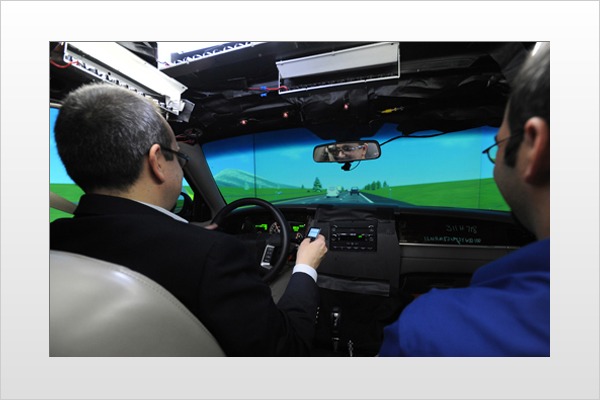
According to U.S. Transportation Secretary Ray LaHood, lives can be saved if drivers would just "put away cell phones and other electronic devices" when they are behind the wheel. Unfortunately, the solution to the problem of distracted drivers can't be boiled down to the automotive equivalent of "just say no."
There's more to driver distraction than just electronics. If all Americans put down their phones or plucked out their Bluetooths tomorrow, distracted driving would still be an issue. That's because distraction is not inherently a technology problem. Research from the National Highway Traffic Safety Administration (NHTSA) says that driver distraction consists of:
Texting on a cell phone likely involves all three types of distraction, but many dangerous driver behaviors don't involve technology at all. "Many distractions increase the relative risk of crashes and near-crashes, and distractions that require drivers to take their eyes off the road are potentially more of a safety problem than purely cognitive distractions," the NHTSA said. In the widely cited Virginia Tech Transportation Institute's "100 Car" study, several activities associated with increased risk of a crash ranked far higher than did using a handheld device, according to the NHTSA:
The NHTSA's data shows that 5,870 people died and approximately 500,000 people were injured in crashes that were reported to have involved distraction in 2008. One national accident database shows that of nearly 7,000 crashes between 2005 and 2007, internal distractions were a critical reason in about 11 percent of crashes studied. About 0.2 percent of drivers were dialing or hanging up phones, about 0.9 percent were adjusting radios/CDs or other controls and about 12 percent were conversing with passengers or were on cell phones.
At this point, however, asking drivers to go on a tech-starvation diet is probably a losing battle. Cars come loaded with technology, and drivers bring their smartphones and other devices into the car with them. Even when laws are strengthened, risky behaviors can persist. Nineteen months after California instituted a ban on texting behind the wheel, the behavior had actually doubled, according to a survey by the Automobile Club of Southern California, which has called for stiffer penalties for texting.
The just-say-no tack also overlooks the existence of car electronics that might actually enhance safety, such as collision-avoidance technology that relies on visual and aural cues to alert drivers. For legislators, drivers and the companies that make or incorporate in-car technology, the answer comes down to helping drivers manage and minimize distraction — whatever the source may be.
The Driver as Listener
Carmakers and tech companies are increasingly responding to the management of distraction by relying on voice-based systems. Ford says it is guided by research showing that "hands-free, voice-based interfaces offer advantages over handheld or visual-manual interfaces for command or data entry while driving and reduce the risk of visual driver distractions." Its Sync technology is a testament to that belief.
The automaker says that when test participants used Sync, an integrated voice-operated in-car communications and entertainment system, to select a phone number or choose a song on their MP3 players, they had a significantly reduced level of distraction compared with the same operations using handheld cell phones and music players. Ford says its research shows that participants "spent an average of 25 seconds with their eyes off the road to select a song with a handheld MP3 player compared with 2 seconds for those choosing a song using Sync."
Audio giant Harman also believes in the power of voice. "Our own research, as well as that from various institutions, shows that hands-free operation of in-vehicle devices is not sufficient for optimum safety," said Brad Hoffman, vice president of communications for Harman. "Well-designed devices must also offer eyes-free operation."
Harman recently acquired Aha Mobile, which Harman describes as a pioneer in converting Web-based content to streaming mobile radio "that allows users to safely access their favorite news, entertainment and social media via in-vehicle infotainment systems or smartphone." The GM-owned telematics provider OnStar, meanwhile, has relaunched itself and is promoting "Responsible Connectivity" that emphasizes voice commands.
Not everyone agrees that voice control is the answer to distracted driving. The Department of Transportation's distracted driving FAQ says that available research "indicates that whether it is a hands-free or handheld device, the cognitive distraction is significant enough to degrade a driver's performance. The driver is more likely to miss key visual and audio cues needed to avoid a crash."
Ford, on the other hand, contends that "cognitive distraction plays less of a role in crashes and near-miss events than previously believed."
Driver Responsibilities
As research continues and government agencies use public education and enforcement tools to manage distracted driving, a measure of responsibility for safety must fall on the drivers themselves. Federal and state governments, private organizations and virtually all manufacturers have education programs aimed at getting teenagers — the titans of texting — to stop using their devices while driving.
Adult drivers would do well to pay attention to their own ability to manage multiple information inputs in their cars. If they find their attention wandering, whether from a Bluetooth-enabled call, a rambunctious dog, an in-car conversation or their dictation of an update to their Facebook page, it might be time to follow the bumper sticker advice from the early days of cell phones in cars: Hang up and drive.